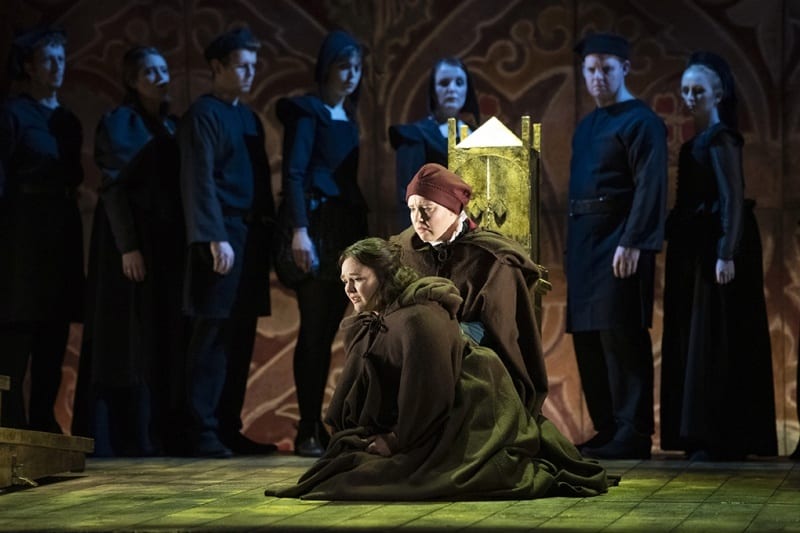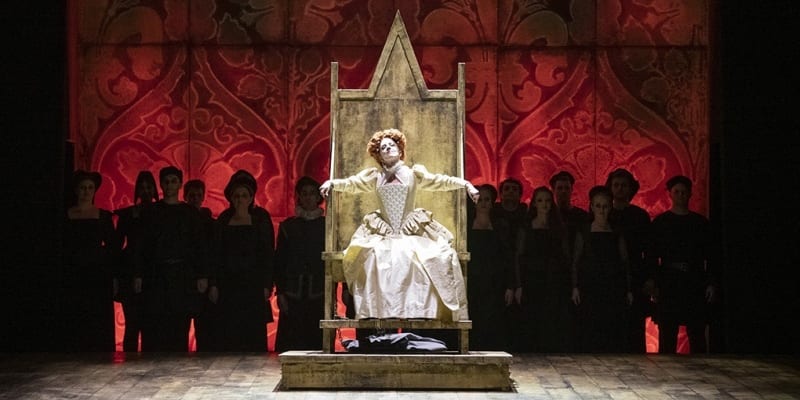Among Rossini’s 39 operas ‘Elizabeth, Queen of England’ is unaccountably neglected. It marked perhaps the most important turning point of his life, as he moved from early success in comic operas produced in northern Italy to take up a new position in Naples, a city with its own operatic traditions and notoriously suspicious of outsiders. 1815 was also the year of decisive allied victory over Napoleon; so a story focused on Elizabeth Tudor was politically apposite as well. This work was his calling card and into it went some of his best music of recent years, including the overture, which we also know as the overture to ‘The Barber of Seville’. ‘Elizabeth’ was a great success, the first of his innovative ventures into his own version of ‘opera seria’, in which recitative is made much more naturalistic, the orchestra gains a more prominent part, and there is far more emphasis on psychological analysis and interplay between different combinations of characters and the chorus.
Part of the problem therefore is that this work is seen as a combination of elements of other works rather than a composition in its own right; and if you add to that a very bizarre and creative take on Tudor history, in which the Earl of Leicester marries a (fictitious) daughter of Mary Queen of Scots you can easily see why the piece has been disparaged and dismissed. But the great triumph of this production by English Touring Opera is to show that it actually works on stage extremely well. Despite its length, time passes effortlessly, with singing and staging of this quality; and Rossini’s particular skill in building up layer upon layer of dramatic and musical complexity ensures that the ends of each of the two acts are splendidly achieved. Rossini was a gourmand and chef as much as a composer: this was a composer who could cook up a storm, and it could be comic or tragic or simply dramatic at will. It is fair to say that this opera is best seen as a layer cake intended to please – light and fluffy but with intense nutty flavours too.
Putting the more than usually preposterous plot to one side, what stands out here are the performances of the three characters in the conventional love-triangle, the vigour of the choral writing, and the invention of the orchestration which increases in its palette of colour and overall prominence as we move into the second act. There is a richness and stylish élan to the staging too that achieves both pomp and circumstance and pathos where needed, and with a finely-judged economy of means.
Dominating the evening both dramatically and musically is the Elizabeth of Mary Plazas who gives us a masterclass in ‘coloratura’ technique that teeters on the edge between regal defiance and womanly despair. This Elizabeth struggles, as in other characterisations, to reconcile her love-life and the requirements of the state; and Plazas allows us to see both sides without overcommitting to either. It is a portrayal that owes a lot more to Britten’s later ‘Gloriana’ than to the stereotype portrayal we find in Donizetti’s overrated (and over-performed) ‘Maria Stuarda’.
She is well complemented elsewhere in the cast: as Leicester, torn between Queen and his wife, Luciano Botelho has some cruelly demanding music to negotiate, but he does this with real skill and plausible acting too. The scene in which the queen offers him her hand and the crown, knowing he cannot accept either, is one of real tension and mental/vocal competition, which they both deliver with flair and passion. No less impressive is Lucy Hall as Leicester’s wife Matilde who stands up to the queen with determination and asserts her own musical and dramatic personality clearly. The role of Norfolk is that of a classic stage villain, but John-Colyn Gyeantey does his best to make it three-dimensional and enjoys some thrilling moments of vocal display which test his top register to the utmost degree.
The stage is dominated by a huge throne, which mirrors Elizabeth’s looming presence in the drama; but it turns out to be a very flexible device providing a structure for the prison scenes as well as other spatial moments. There is plenty of room therefore for director James Conway to manoeuvre the substantial chorus of people and courtiers who memorably endorse or challenge the main characters in thrilling ways that seem to anticipate Verdi. In the pit John Andrews has a fine evening developing characterful solos especially from the horns and woodwind and setting speeds that never drag yet support the singers too.
This is a truly notable revival and English Touring Opera are doing a notable job in drawing it to our attention once again. One hopes that the Art Council notice and reward this work of creative outreach and rediscovery.

